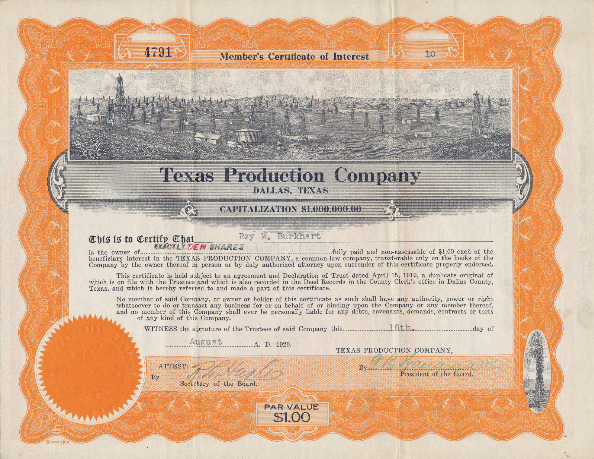by Bruce Wells | Mar 26, 2025 | Petroleum Pioneers
Some thought the 1911 oil discovery at Electra was an April Fool’s Day joke.
When a geyser of oil erupted from the Clayco No. 1 well near Electra on April 1, 1911, the giant oilfield discovery launched a boom that brought prosperity and more drilling to North Texas. Lawmakers would name Electra the “Pump Jack Capital of Texas.”
Just south of the Red River, Electra was a small, cotton-farming community barely four years old when petroleum exploration companies rushed to North Texas in 1911. (more…)
by Bruce Wells | Apr 14, 2018 | Petroleum Companies
 Texas Production Company was incorporated on June 18, 1917, with $1 million in capital. It would find oil in booming North Texas oilfields – but not survive the competition.
Texas Production Company was incorporated on June 18, 1917, with $1 million in capital. It would find oil in booming North Texas oilfields – but not survive the competition.
By 1919, Texas Production completed the Renner No. 1 well at 475 barrels of oil a day from the Waggoner oilfield, near Electra and the recent extension of the Burkburnett field (Electra would someday be declared the Pump Jack Capital of Texas).
According to the Texas Historical Commission, exploration and production in this area was minimal until April 17, 1919, when the Bob Waggoner Well No. 1 blew in producing an astounding 4,800 barrels of oil per day. It was the first well in what became known as the Northwest Extension Oilfield, comprised of approximately 27 square miles.
Oil had been found in 1912 west of Burkburnett in Wichita County, followed by another oilfield in the town itself in 1918. The Wichita Falls region’s drilling booms inspired a 1940 Academy award-winning movie. Learn more Boom Town Burkburnett.
The company also appears to have drilled productive oil wells in the in the Humble oilfield of Harris County, bringing in the Bissonnet No. 1 well to a depth of over 4,000 feet, one of the deepest – and one of the most expensive – in the field at the time.
Although that well reportedly produced up to 2,000 barrels of oil a day in 1921, competition for leases and equipment intensified amid falling oil prices. In the same year, a Texas Production Company investor sought advice from a leading financial publication. The answer was not promising.
“So far as we can make out you bought into an oil production of little or no merit, which has simply gone the way of any number of such enterprises,” United States Investor noted.
“Shares of the Texas Production Company are now being offered at a few cents a share by unlisted brokers which would indicate that a sale of your stock would net you little,” the magazine added. “There is no way for you to get your money back.”
United States Investor encouraged its readers to avoid investing in any questionable petroleum-related bonds. “This may be a time for strong companies to invest in oil at a low figure,” Investor proclaimed, “but a company which must bond itself to pull itself out of a hole can’t do much in the way of speculation on the future price of oil to get back for its stockholders what has been already taken by unscrupulous promoters.”
Texas Production Company’s stock certificate includes the same vignette of derricks seen on those of other companies quickly formed in booming oil regions, including Centralized Oil & Gas Company, the Double Standard Oil & Gas Company, the Evangeline Oil Company, and the Tulsa Producing and Refining Company.
___________________________________________________________________________________
The stories of many exploration companies trying to join petroleum booms (and avoid busts) can be found in an updated series of research in Is my Old Oil Stock worth Anything?
The American Oil & Gas Historical Society welcomes sponsors to help preserve petroleum history. Please support this energy education website with a contribution today. Contact bawells@aoghs.org for membership information. © 2019 AOGHS.


